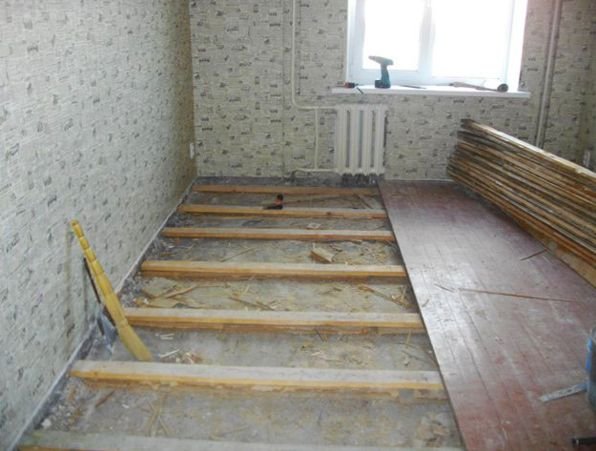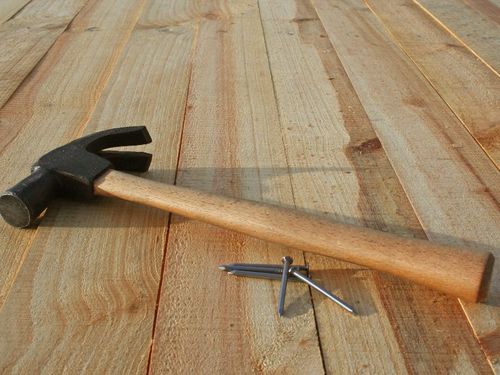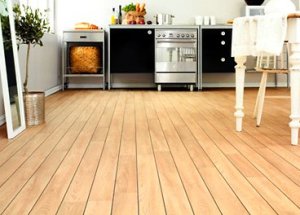Life - a very interesting thing, in it, even such trifles as the creak of the old wooden floor can make a big difference. It's amazing how you did not notice it before? And now this annoying creak in the apartment really spoils your life! What to do? There is a fairly simple solution, but first let's look at the causes of this unpleasant phenomenon.
Content
Why creaks floors

Crying a wooden floor in an apartment can only for one reason - and this cause is friction. That is, the tree rubs against a tree. If in more detail, the boards lying on wooden logs, which serve as the basis for the floor, rub against each other, and on these same lags. Also, wooden boards can rub against nails. But why? The reason may be poor quality of the wood from which they are made, improper installation or operation. Of course, all these reasons can be present in the aggregate. But in the appearance of the creaking is not so important, the quality of the wooden floor in the apartment or not, he still begins to squeak. In the case of qualitative stacking - less intensive, in the case of poor quality - more. It's only a matter of time. The quality floor will begin to squeak in about five to six years, and poor quality - after a year of operation. That is, the creak of a wooden floor is only a matter of time. But this does not mean that it is useless to deal with this unpleasant phenomenon. You can fight and even need to. But how to eliminate the creak of a wooden floor in an apartment? We'll talk about this later.

What to do if the wooden floor creaks
Of course, the fight against squeaking is mainly to eliminate its causes. And since the cause of the creaking, as we said above, is, most often, the friction of the tree against the tree, then by preventing (or eliminating) it, we get rid of the problem. It would be best to think about this when initially laying the floor on a concrete foundation. An important role is played by rubbing the boards against each other. Grinded boards will start to creak later and not so much. And in order to prevent the boards from touching the wooden logs, we must lay a cloth (or geotextile) between them. During the repair of the floor, this can also be done, but for this you have to shift all the boards again. By the way, if the lags are laid quite often, then there is less probability that the floor will soon begin to squeak heavily. If, on the contrary, the distance between the lags that are the basis of the floor is large, then the boards will loosen faster and the squeak will be more intense. Also it is necessary to pay special attention to reliability of fastening of logs and boards.

Eliminate the creak floor in the apartment

But it's about friction boards about lags. And what to do with the fact that the boards rub against each other, crouching and staggering, than they cause a lot of inconvenience to all household members? So, we remove the creaking of the floor in the apartment. As we have already said, it is best to shift the entire wooden floor anew, replacing the boards with new ones (in this case it is advisable not to save on their thickness and take boards not less than 4 cm thick).

In this case, it is necessary to pay special attention to the tree from which they are made. In our country, for the most part, spruce or pine is used for this purpose. But this is not the best option. Pine became a tree for the manufacture of floorboards only in recent years. Fashion on it came from Europe, where almost constant humidity and very mild (in comparison with domestic) climate. Earlier in our country only wood was used for this purpose, which is known for practically not absorbing moisture, such as oak, ash, cedar or maple. But why? Because the floorboards after laying several times then absorb moisture, then dry out (depending on the season), as the wood is known for its excellent absorption of moisture from the air and also gives it well. And, the less moisture absorbed by the floorboards, the less swell, and therefore less deformed and begin to creak.
It is common knowledge that the moisture of spring or autumn differs from the humidity of winter or summer. In spring and autumn, humidity is always increased, the floorboards absorb it well and swell, deforming and expanding. In winter, in the heating season or in hot summer, the humidity is very low, from which the floorboards dry up, shrink, decrease, thus, the gaps between them are formed of different diameters. The year passes, the second, the third, and after a certain number of cycles of drying and swelling, the resulting gaps become so large that the floorboards begin to literally slide along each other. When they attack them, they bend and shift, rub against each other, creak. Means, repair is required. We already spoke about the effective way of repair work. This is a complete rearrangement of the floor with the removal (and possibly replacement) of the boards, as well as laying a textile layer between the boards and lags to prevent squeaking. Now let's talk about another, less expensive and troublesome way to eliminate sexual creaking.
The ways to eliminate the creaking of a wooden floor

The simplest (however, not very reliable) way to eliminate the creaking of wooden floor boards is its propeny from the inside. But this is a very inefficient and short-lived way for the lazy. We will not describe it. Yes, there is nothing to describe, in principle. Just under the boards foam is poured, it increases, filling all the underground space, and hardens. The boards are thus raised and installed at approximately the same level, acquiring, though short-lived, but still some - no foundation.
Another, more effective and also simple way of repairing a wooden creak floor is to prick up old nails or drive new ones in places of contact between boards and lags. Can help and its scrolling. In this case, it is necessary to screw in a pair of screws at the places where the board is attached to the lag. Self-tapping screws are more reliable material than nails in repairing a wooden floor. You just have to try to screw them deeper and, preferably, into the middle of the lag.
Quite rare, but still there is a situation where the problem of sex creaking is in poorly fixed lags. This is an exception, because well-fixed lags - this is the basis for laying the floor, so to speak, the basics of construction. If there is still a problem in this, then, without removing the boards, you can try to fix this problem by drilling long dowels to the concrete at the locations of the lags.

If, however, using all the simplest methods of repairing the wooden floor, he continues to creak, then there is nothing else than to begin the above described overhaul of the floor with its opening and full (or partial) replacement of the boards and reinforcement of the lag with the laying of tissue between them. This method is undoubtedly the most costly and time consuming, but, nevertheless, the most effective one available today.



















